Public Pier — No Fishing License Required
Technically this is the “Old Ferry Landing” Pier but to most it’s simply the Coronado Pier or Ferry Pier. I spotted this small pier one day from the downtown side of San Diego Bay. I drove across the Coronado Bridge, was unable to find the pier and left it out of the first edition of Pier Fishing in California. Later, I found directions to the pier and could have kicked myself because it is so easy to reach. It sits behind a shopping complex and although completely hidden by the shops, it’s a short, easy walk from the corner of the street.
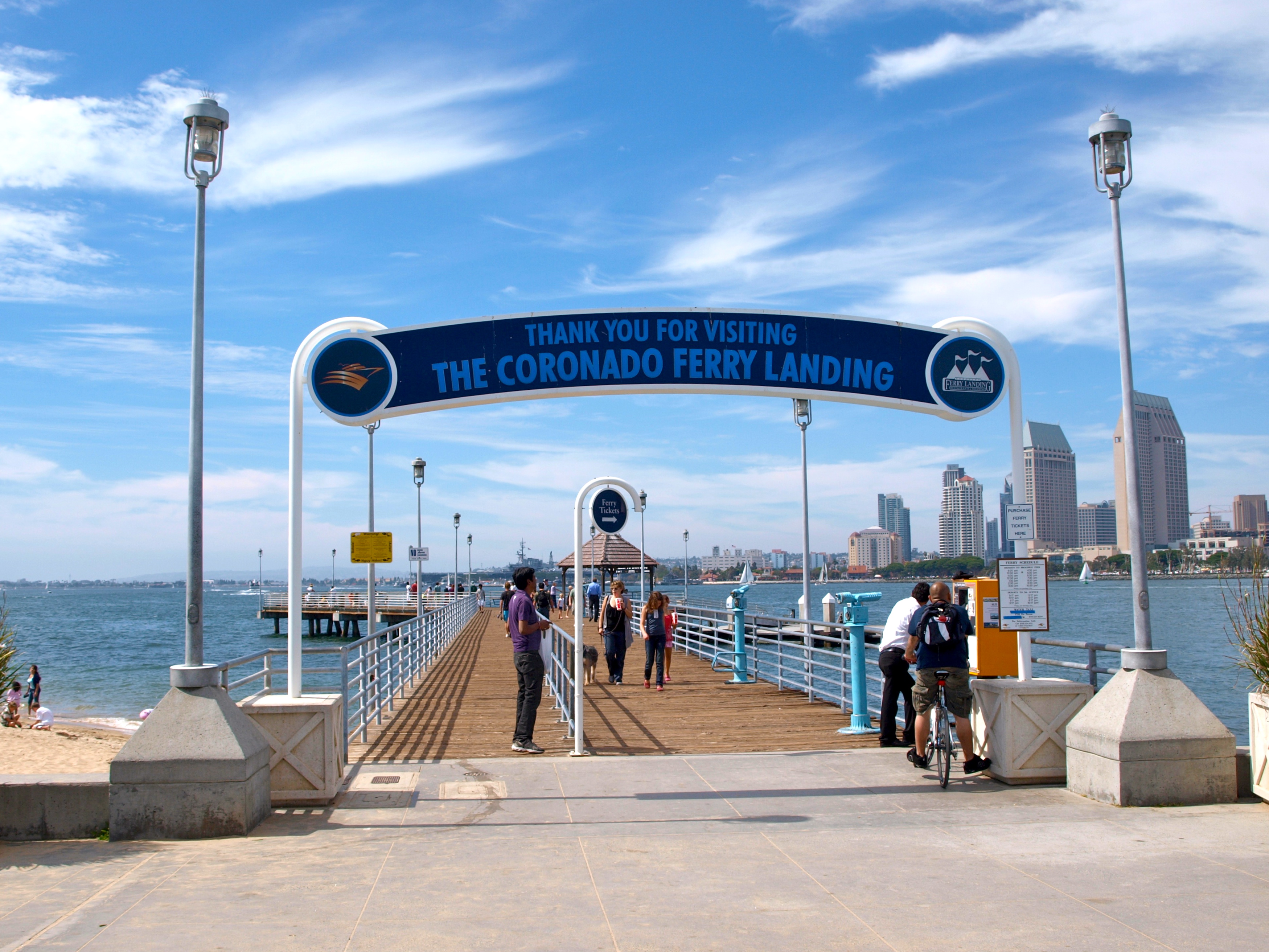
I do sometimes wonder if the pier could use a change in name— to “Stingray Central.” I have rarely had a trip to the pier when I haven’t caught at least one round stingray, and I average more than two of the fish per trip. It doesn’t seem to matter what bait I am using on the bottom—bloodworms, ghost shrimp, squid or pieces of fish like mackerel—the small rays will find the bait.
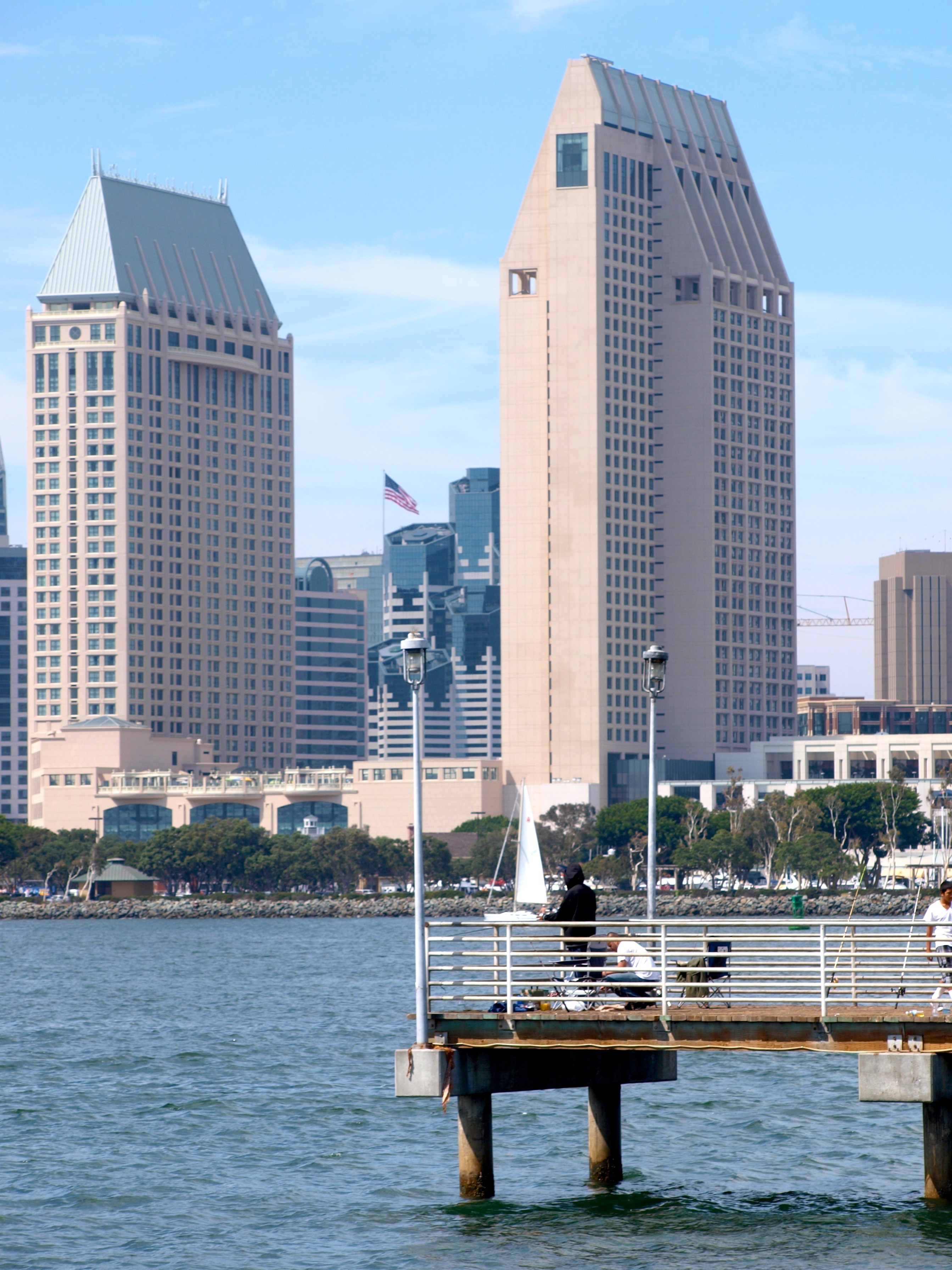
Environment. The pier is small (377 feet long) and although part of it is a boarding area for the ferry, the part that is open for angling yields quite a few fish. The bottom here is primarily sand and mud with several grassy areas around the pier, especially on the shore side of the pier. The pilings themselves are somewhat encrusted with fish attracting mussels. At the right of the main pier section sits the landing for the ferry and a lot of fish like to hang under that landing. Because of the pier’s size, the water depth is fairly shallow but because of the grassy areas quite a few bass—sand bass, spotted bay bass and kelp bass—seem to be caught.
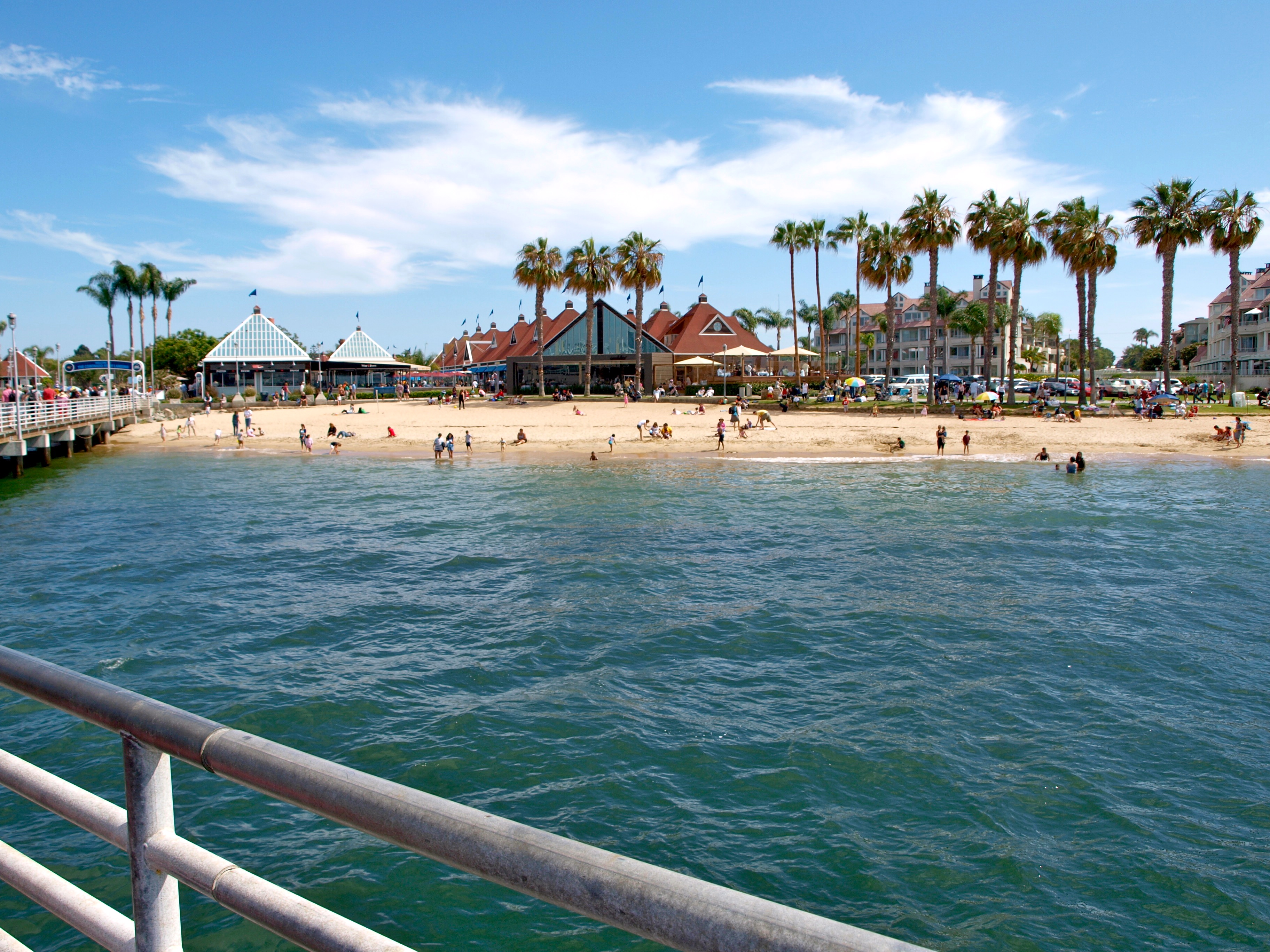
Fish. The overall mix of fish mirrors, for the most part, that of most piers located in southern California bays: jacksmelt, topsmelt, mackerel, and (some years) bonito on the top; bass, perch, croakers, halibut, turbot, rays and sharks on the bottom. Initially I thought that the pier would yield less mackerel and bonito than piers near deeper water. But I was wrong! The water is plenty deep on the bay side, is often good for mackerel, and is at least fair for bonito during the years when they make an appearance.
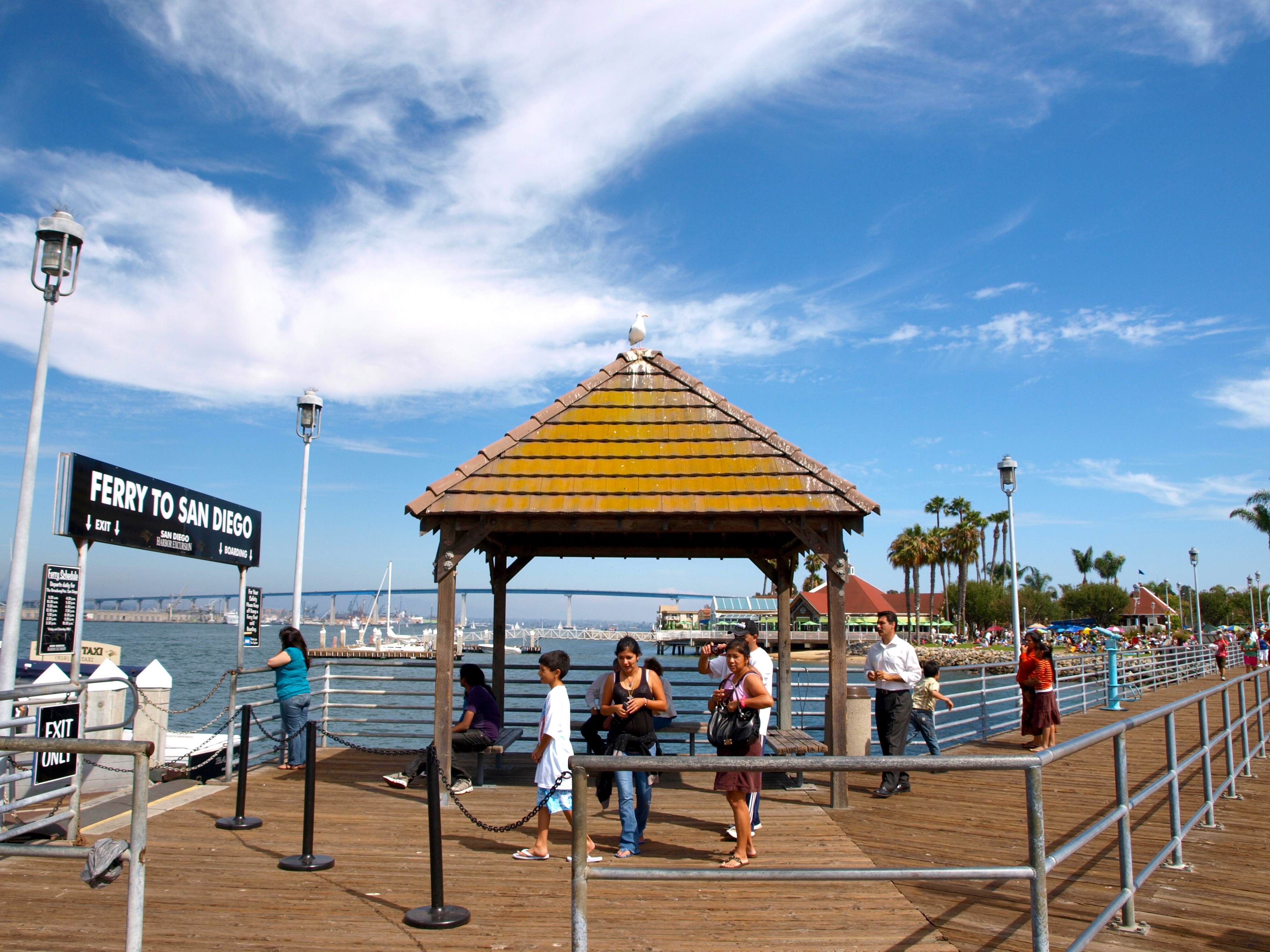
In addition, the waters in South San Diego Bay are noted for quite a few warm-water, Panamic Province species, fish more common to Baja south. Numerous Cortez bonefish (Albula gilberti) have been landed and shortfin corvina (Cynoscion parvipinnis) are an increasingly common catch. A banded guitarfish (Zapteryx exasperata) was caught in August of 2002 and another in October 2021. A big California butterfly ray (Gymnura marmorata) was landed in September of ’02, and a speckled midshipman (Porichthys myriaster) was taken in May of ’06. Of course the latter is perhaps not that unexpected given the number of Navy personnel in the area.
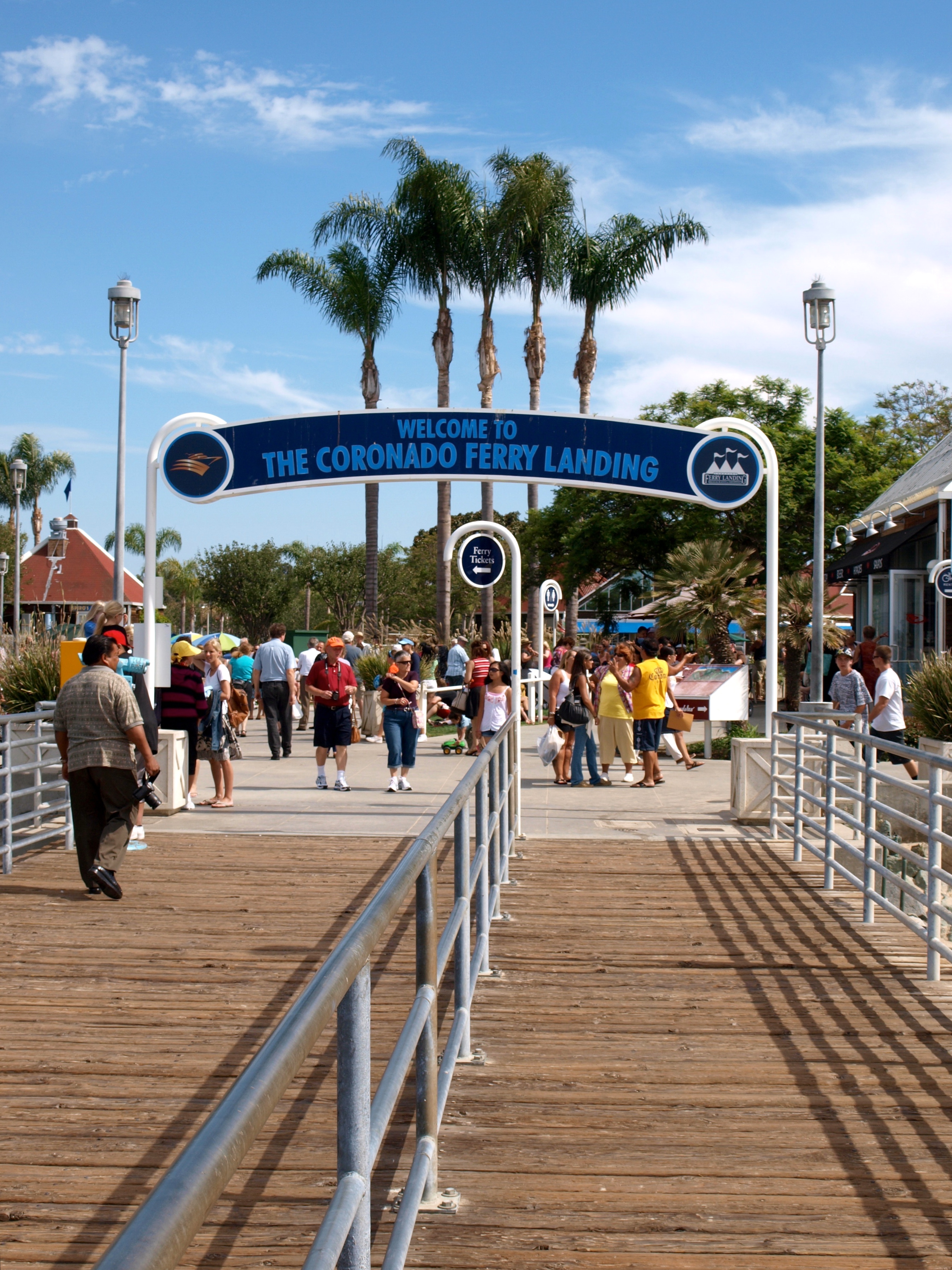
A fish becoming more and more common is the giant (black) sea bass. A baby of around 30 pounds was landed (and released) from the pier in May of 2009 and almost every year since has seen at least one of the illegal to keep fish. In September 2016, a lucky angler landed a finescale triggerfish (Balistes polylepis). Why lucky? Because they are a rare fish to catch in the bay and because they are also one of the best eating fish. Of course their super tough skin (almost like rawhide) can dull even the best knife.
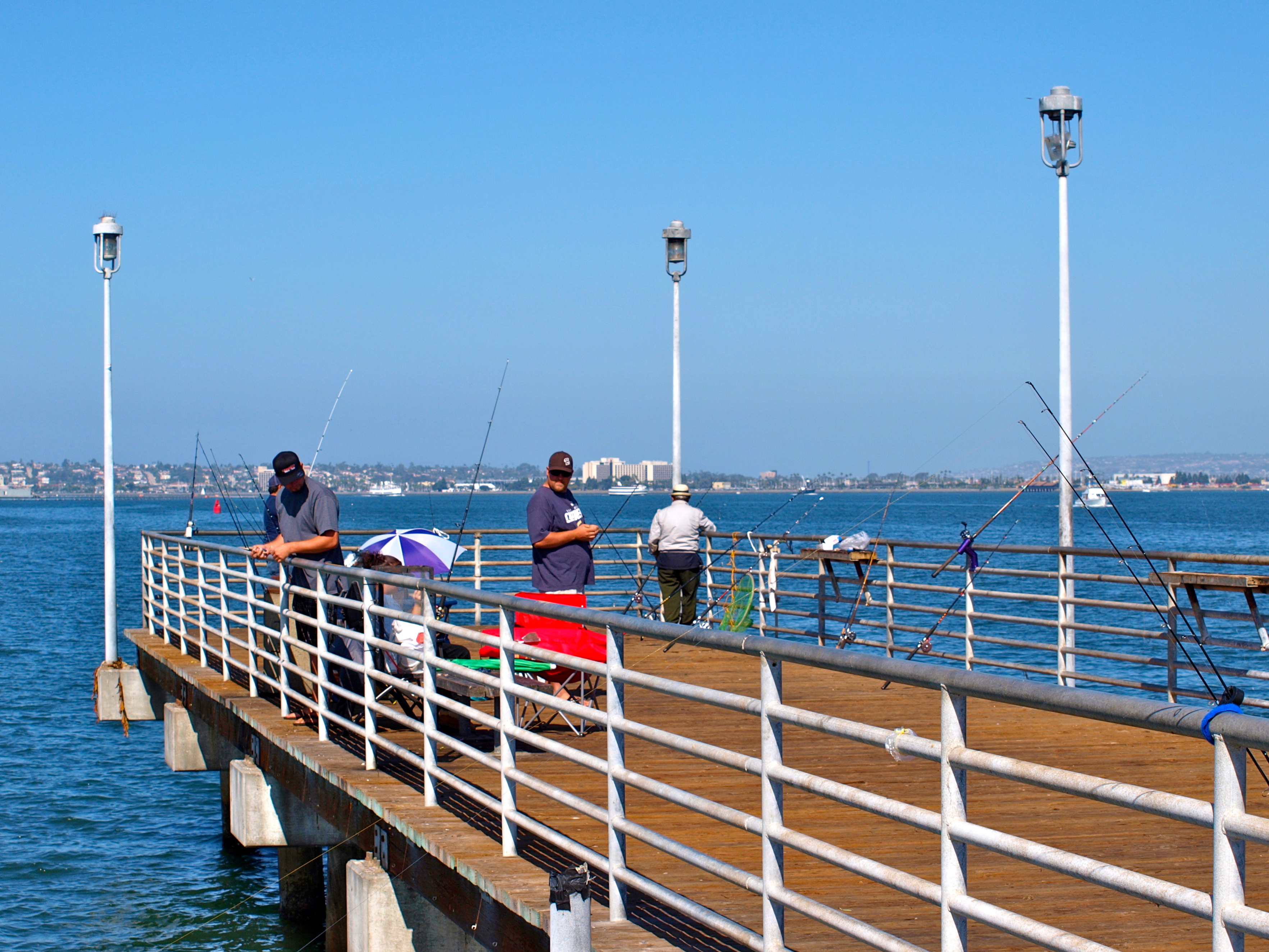
Fishing Tips. Several different approaches can be tried here. First is to buy an umbrella drop net. Attach a few pieces of bread to the net, drop it down into the water, and catch yourself some small smelt or anchovies. Then, using the live bait, fish directly under the pier (or off the far left corner) on the bottom for halibut. Or, try in the grassy areas for barred sand bass, spotted sand bass and kelp bass. Try near the landing dock for bass in both quantity and quality.
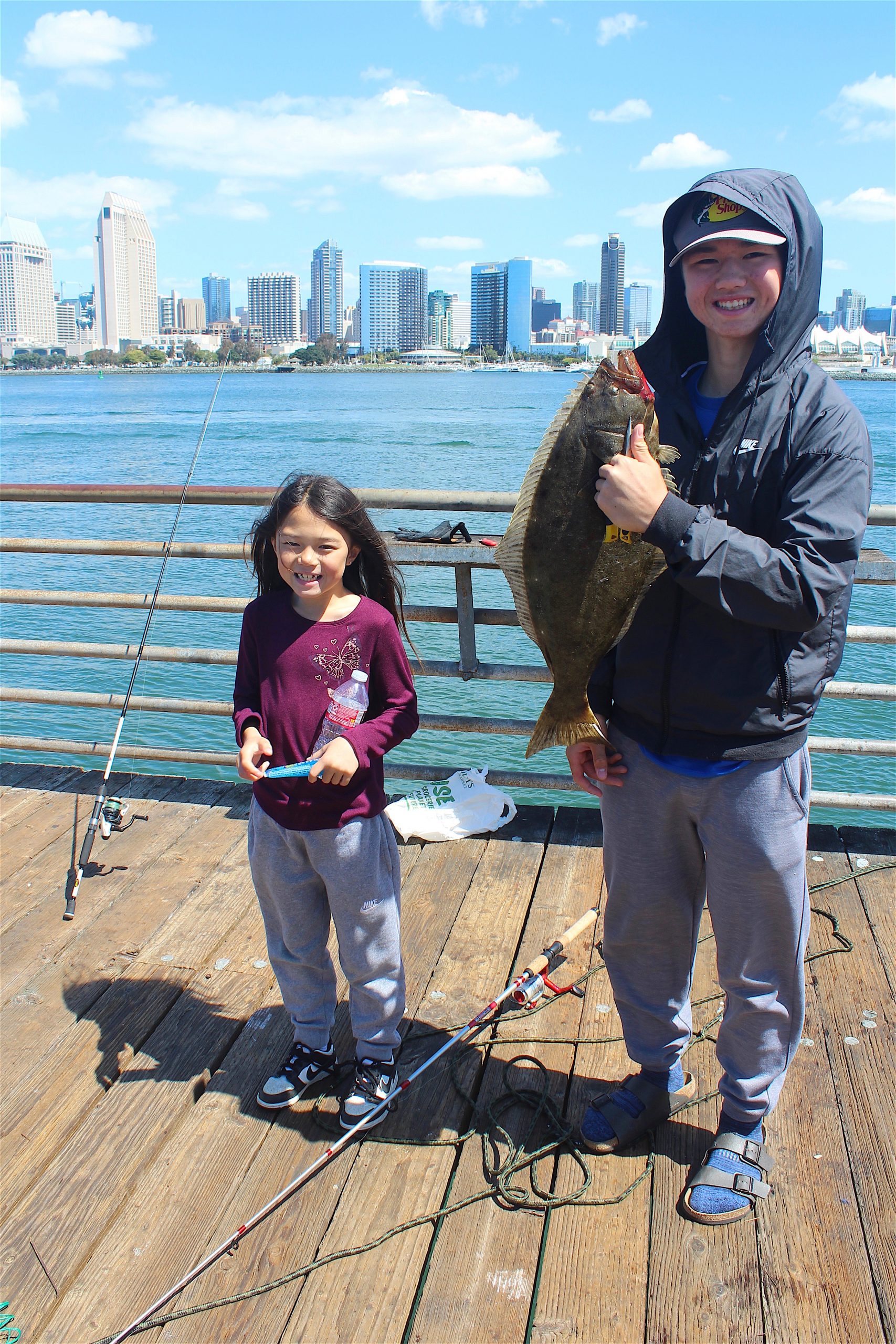
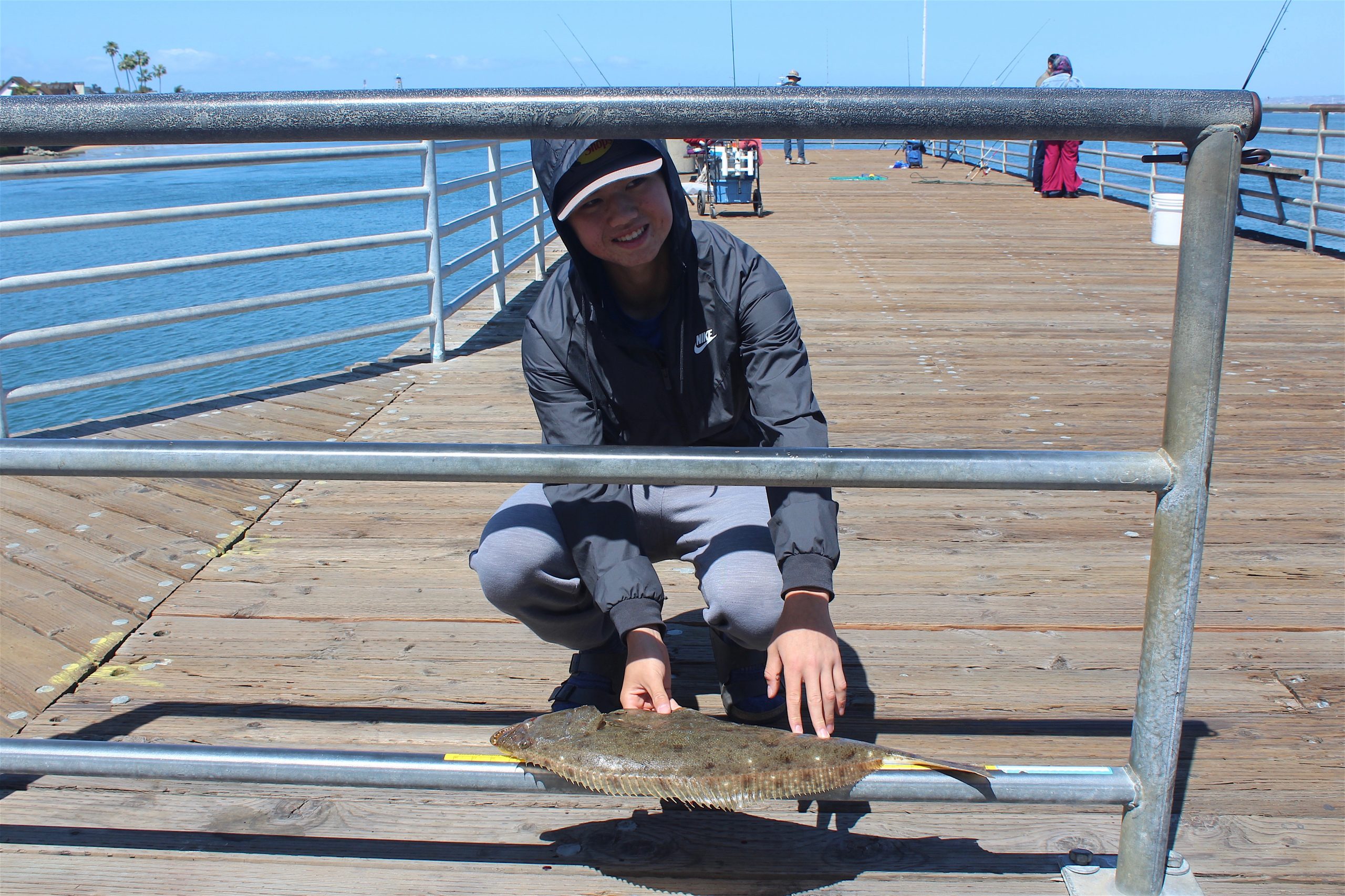
A 26-inch halibut caught in April 2024.
During the spring, try fishing in the grassy areas with bloodworms, mussels or ghost shrimp for blackperch, white seaperch, rubberlip perch and sargo. Fishing on the bottom or mid-depth, while using small hooks, size 6 or 8, and pieces of anchovy or mackerel, will sometimes also yield herring (queenfish) or tomcod (white croaker). Salema are also a frequent visitor.
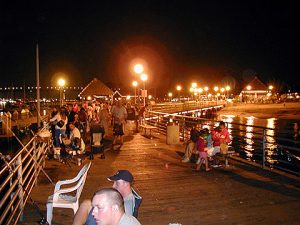
At night this can be a good pier for sharks and rays. Casting out away from the pier and using mackerel or squid as bait, will often result in gray smoothhound sharks, leopard sharks, bat rays, shovelnose sharks (guitarfish) and a few thornback rays.
As mentioned, this pier, both day and night, also yields a lot of stingrays. Although I caught one of the larger and less common diamond stingrays (Dasyatis dipterura) in a visit in July of 2007, the vast majority of stingrays will be the smaller-sized round stingrays (called stingers and teacup saucers by some of the PFIC regulars). Handle them with care but return them to the water.
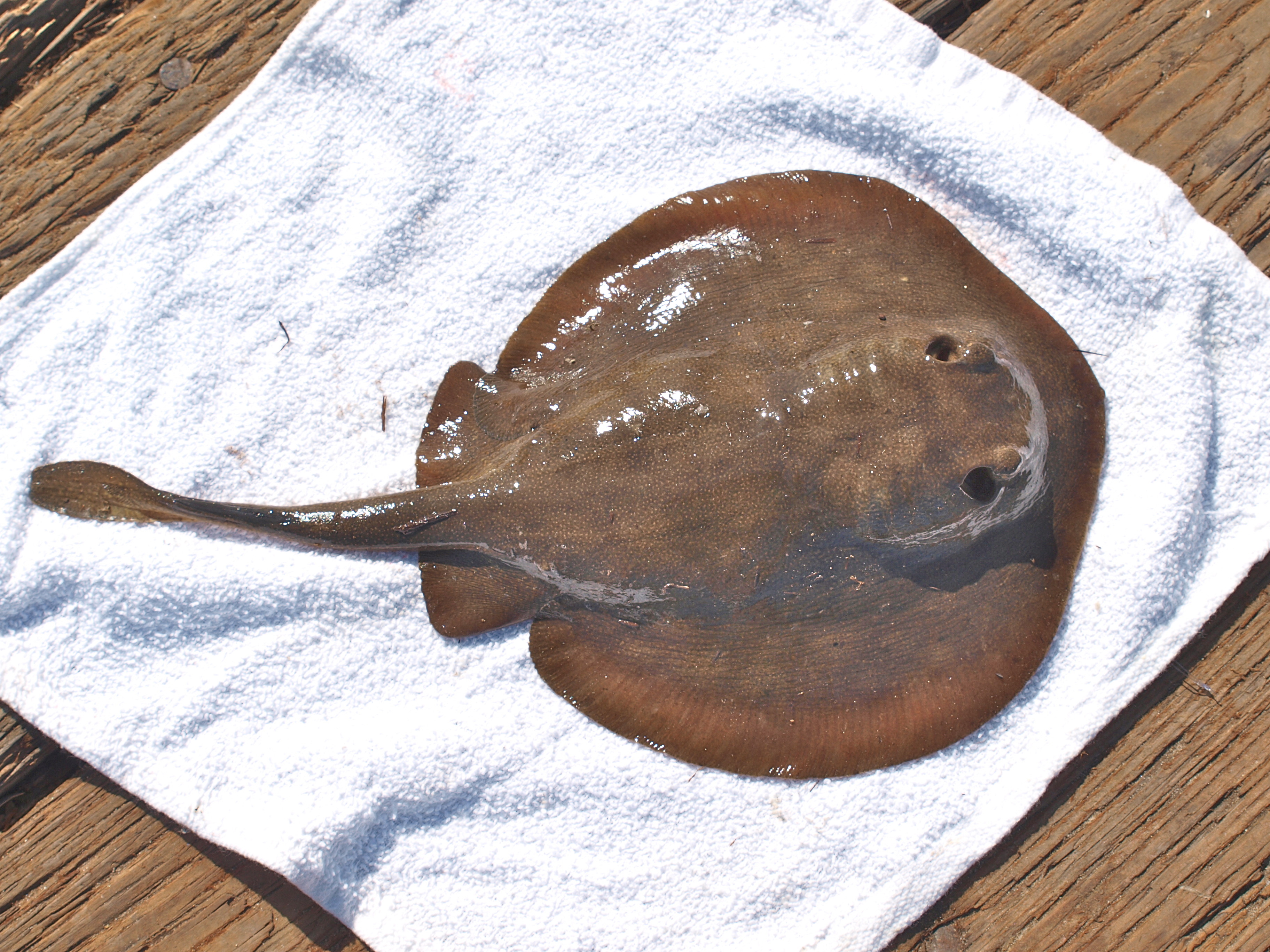
Round stingray always seem to show up even if uninvited
A visit to the pier in October 2021 saw me witness the capture of a banded guitarfish, a species more common to the south.
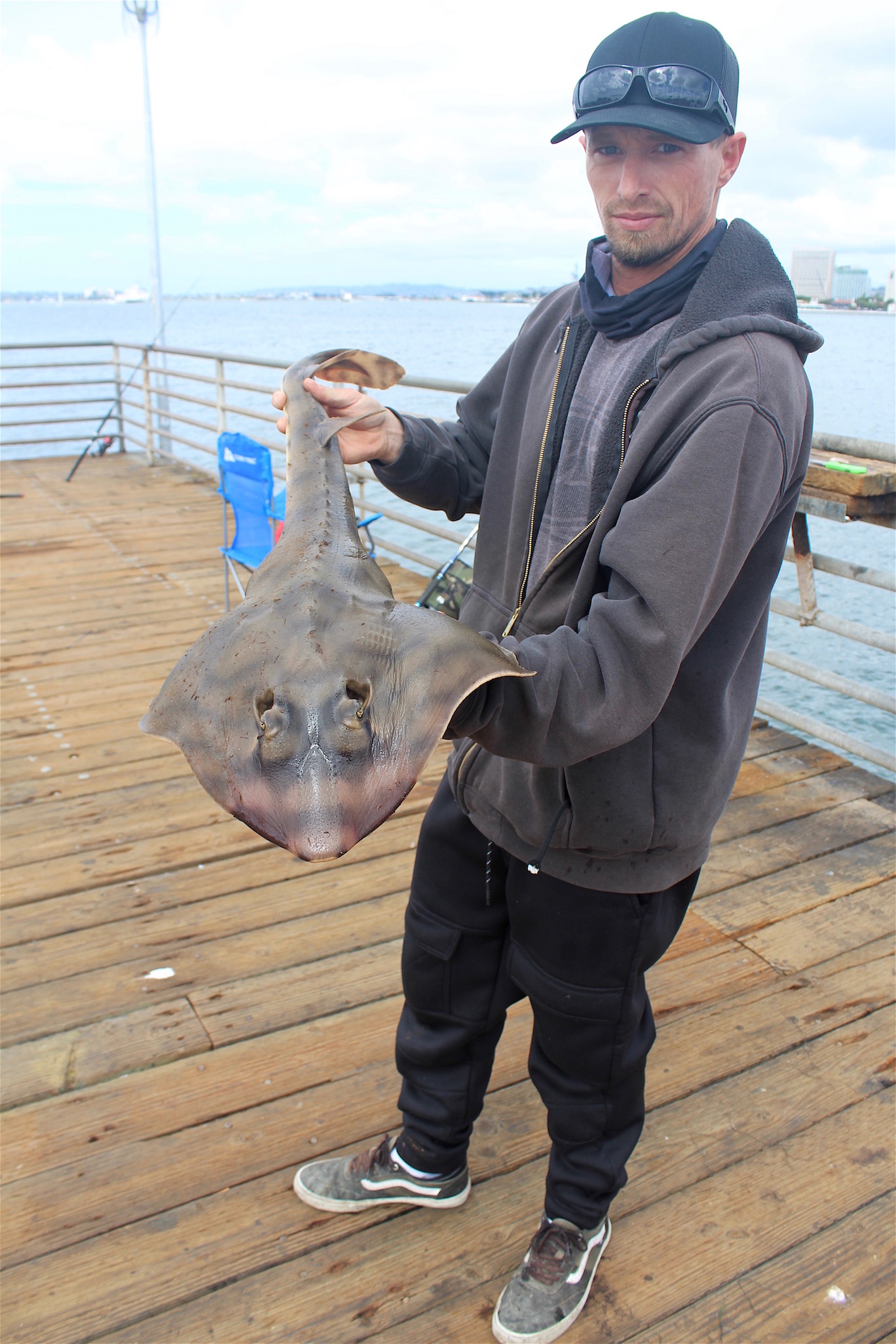
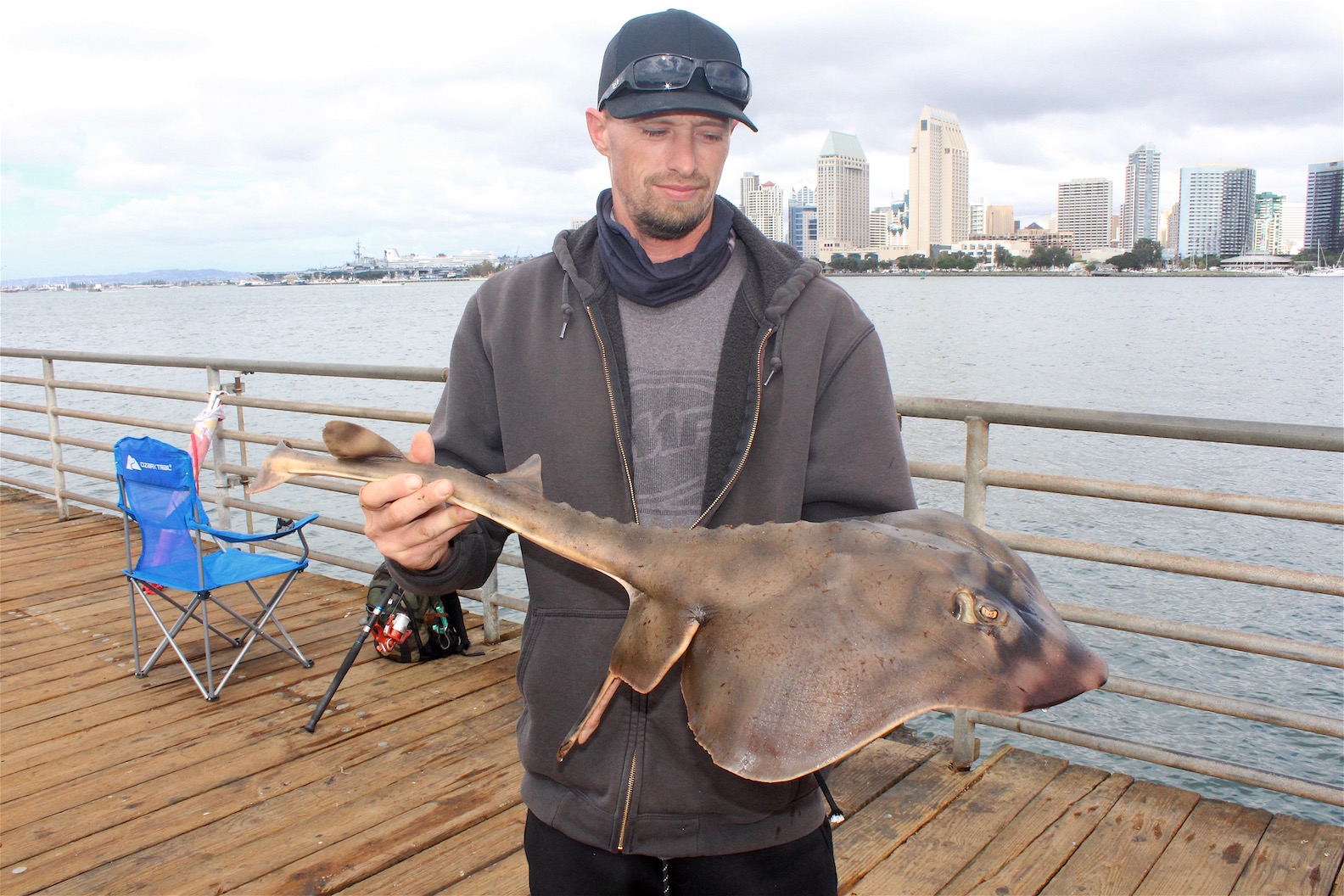
In talking to the angler, Cody Goodwin, it turned out that he had also caught a large soupfin shark two weeks previously, a 72-pound, 6-foot-long shark. Not a bad combo.
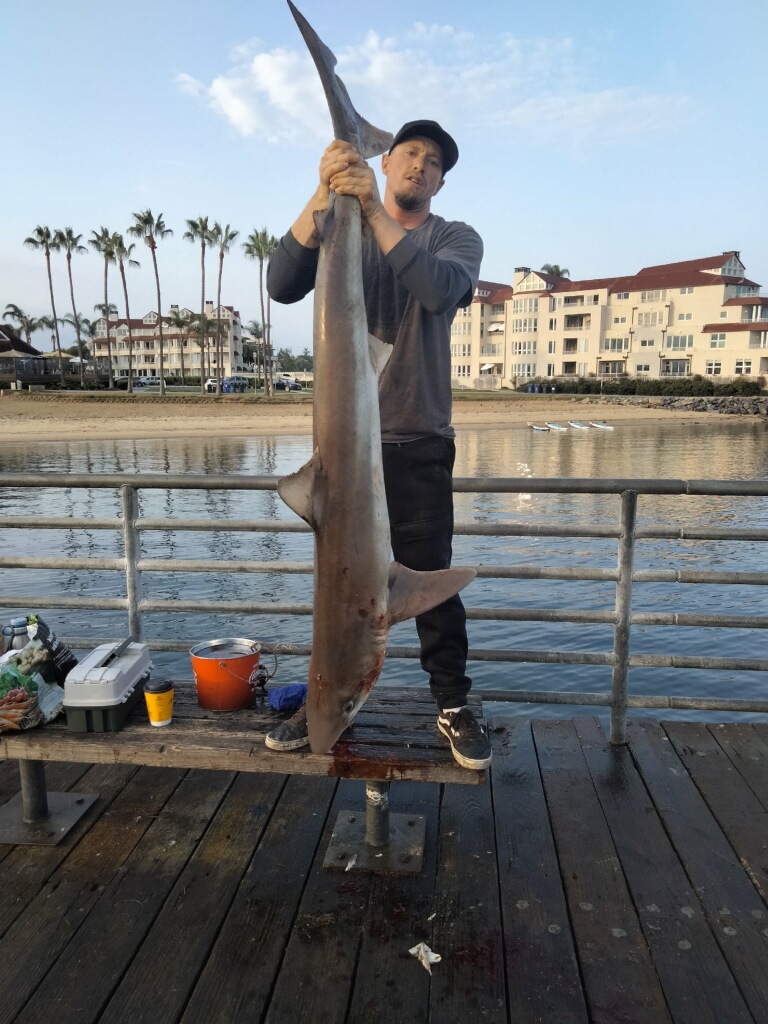
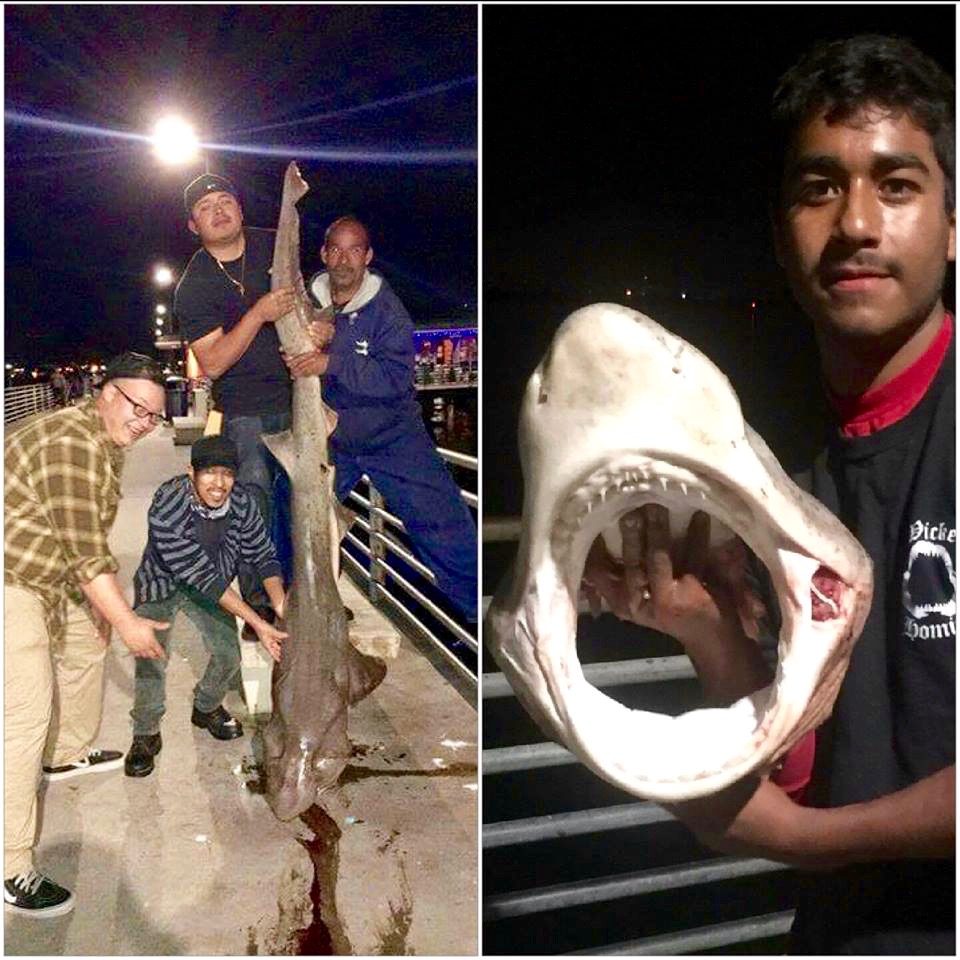
This Seven-Gill Shark was taken by Beto in February 2016.
Nocturnal hours are also very good for the croaker clan—spotfin croaker, yellowfin croaker and an occasional black (China) croaker. A close relative, sargo, can also be included in the gathering. For these, use a high/low rigging on the bottom and use bloodworms, mussels or ghost shrimp as your bait.
Another croaker, the shortfin corvina , is (as mentioned) becoming a somewhat common catch at the pier. Although recorded north to Huntington Beach, shortfin corvina are fairly rare to California waters preferring the warmer waters to the south in Baja. Recent studies seem to show that a population exists in south San Diego Bay. Most shortfins are taken at night, especially during the warmer-water summer months, and both baits and lures (including top-water plugs, Fish Traps, Big Hammers, and Berkley Gulp Minnows in pink or green—among others) are used to capture the toothy croakers.
The shortfin corvina should not be confused with white seabass or corbina, two other croaker species found in these waters. Nor should they be confused with the orangemouth corvina, the large corvina once so common in the Salton Sea. Just to add to the confusion, don’t mix ‘em up with their other giant brethrens—totuava, red drum (channel bass), or black drum, all fellow members of the distinguished croaker clan. And, thinking in ways most strange, I wonder what a tartan of the croaker clan would look like?
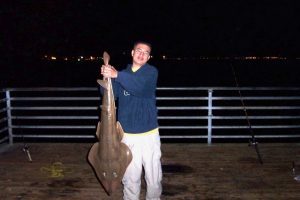
Shovelnose (shark) guitarfish caught by adieboy801 in 2003
For mackerel or jacksmelt try a multi-hook bait rig, i.e., Sabiki or Lucky Lura. Cast out, let the line sink part way to the bottom and then start a slow but steady retrieve. If the mackerel are wary, switch from the bait rig to a single hook. Put a size 4 or 2 hook on the end of your line and add a split-shot sinker or twist-on sinker three foot above the hook. Keep your bait 6-8 feet under the surface of the water (and you may find that you also need a bobber or float to do it). The key is to get the bait down to the mackerel that like to hang under the schools of smelt. The smelt will attack the bait and nibble it with their small mouths but then the mackerel will rudely barge in and grab it. When the mackerel are around you should have no problem catching a stringer of fish.
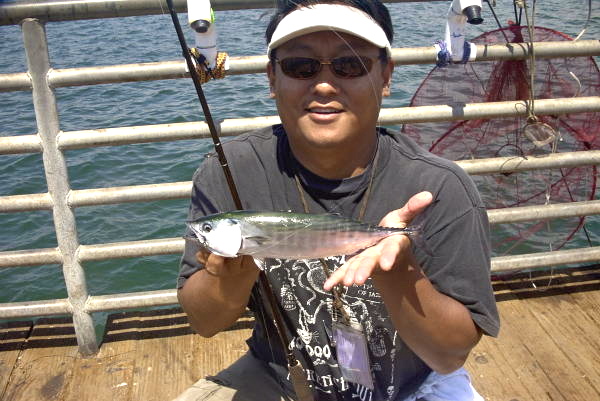
A small bonito caught by SDBrian
If Pacific bonito make a showing, artificial lures seem to offer your best chance for success. A plastic Cast-a-Bubble with a trailing feather (yellow and green are primo) about 3-4 feet behind often yields the best results. Barracuda will also sometimes also show up, generally in the late afternoon or evening hours, and again an artificial lure, a chrome jig like a Kastmaster or Krocodile, often proves best. Rich Reano, the webmaster for the Pier Fishing in California web site, and once a reporter for the pier, says he has even seen barracuda taken here on Salas iron jigs.
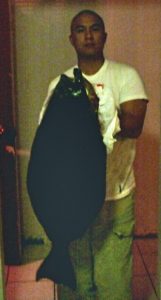
A large California halibut caught by pescador
This is also a pier that seems to see a lot of California needlefish (Strongylura exilis), prey that are fun but difficult to catch. If you want to seek these, use live bait fished under a bobber or float, and cast just out from the pier. Use a size 6 hook and expect to lose at least a half-dozen baits for every needlefish that you hook. Some also suggest a strip of squid fished much like a lure; cast out and retrieve quickly.
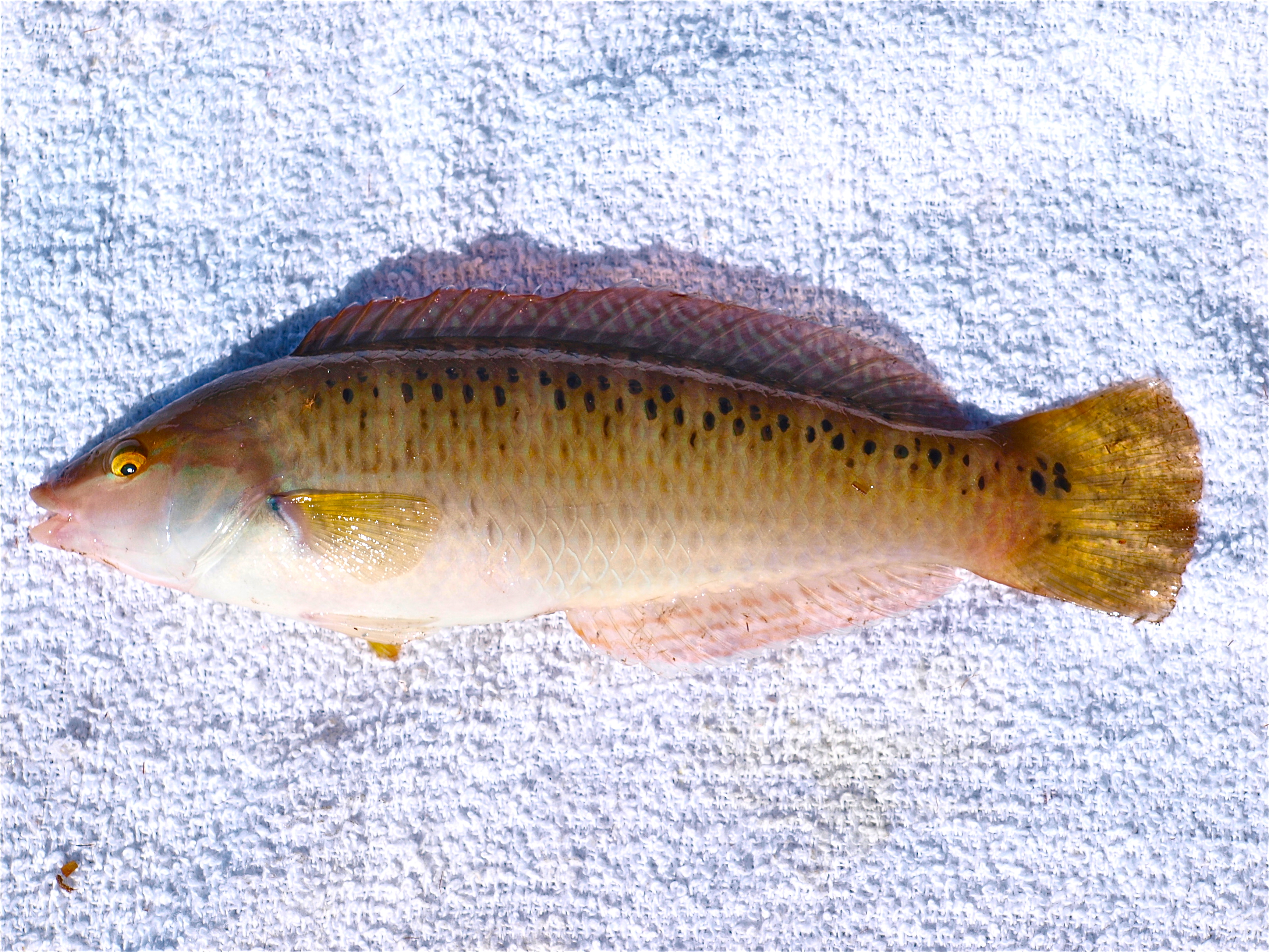
Rock wrasse
Lures will, of course, also take several other species. Perch will sometimes hit a soft plastic grub, while spotted sand bass, barred sand bass and kelp bass will strike many different types of lures. Favorites include small 3-5 inch Scampis and Scroungers, Haddock Kreepy Krawlers and Berkley Power Sand Worms. Swim baits are also popular as well as more exotic combinations like swim baits with a rattle added, and Strike Lites—a lure designed to be used at night. One hint is to use freshwater jig heads that have smaller hook diameters since they are sharper.
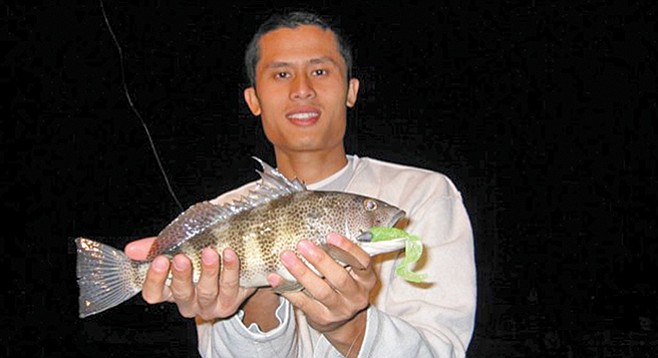
A good technique to use when using artificial lures around the pier is to drop the lure straight down alongside the pier. Let the current sweep it under the pier, wait a few seconds, and then begin your retrieve. Often the fish will hit it as the lure is descending to the bottom or when you begin the retrieve. Or, you can try a lift and fall technique since you are somewhat limited in the area you can fish. The key is to keep the lure around the structure of the pier, do not work the lure away from the pier.
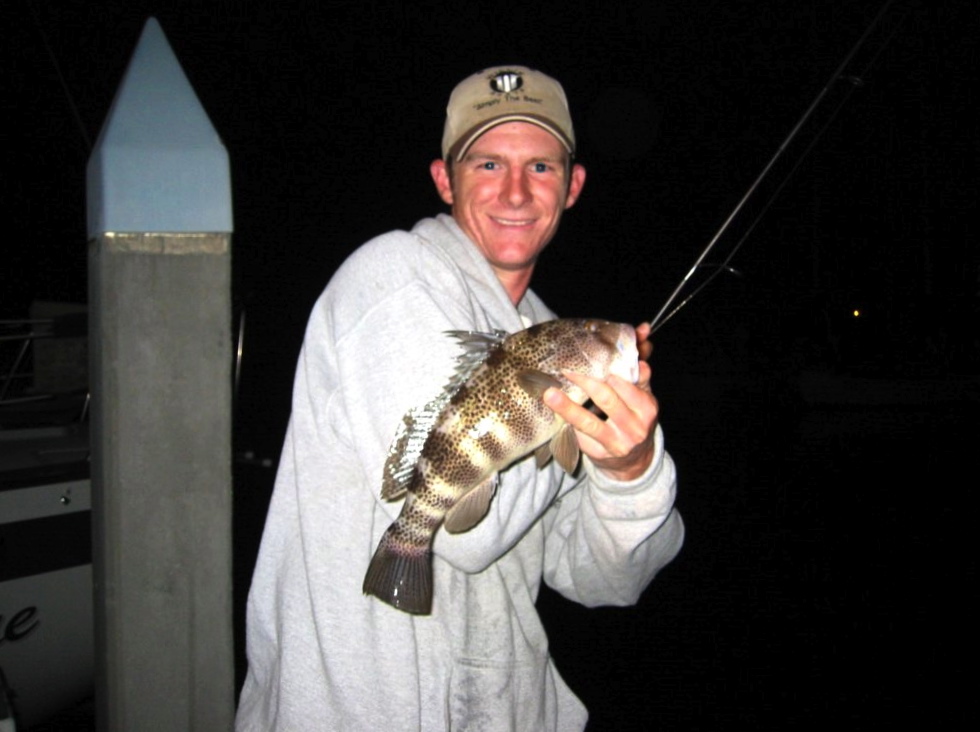
Spotted sand bass
Both Fish Trap and Big Hammer lures have also proven effective on halibut with the waters inshore of the pier usually being more productive. Light tackle, by the way, is generally the preferred method at this pier. Water here is often crystal clear and the fish can be very wary of the heavier lines, especially during the middle of sunny days.
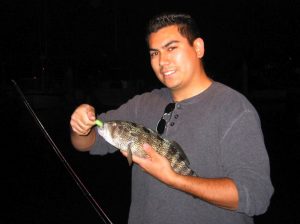
Spotted sand bass
Diamond turbot, the small cousin to halibut, are also available. Most are caught on high/low rigs or Carolina-type rigs using small hooks, generally size 6 or 8 (since they have small mouths) and bloodworms, small pieces of shrimp, pieces of fish, or strips of squid.
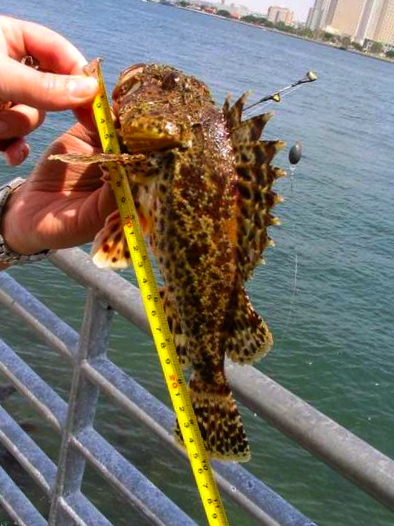
California Scorpion, usually called sculpin by most anglers (although in the rockfish family and not the sculpin family) make an occasional appearance. Be very careful that you do not get stung by one of many spines. Also be sure to measure that they are legal size (currently 10-inch minimum size).
The Pier Rats Speak
Date: August 9, 1997; To: Ken Jones; From: Ritchie Reano; Subject: Reporter for Coronado Ferry Landing Pier
Howdy! Great site by the way and I do have your book. I fish the Coronado Ferry Landing Pier almost exclusively. Here’s my report. All around great pier. Varied species. Small pier, no concession or bait stand, but the Ferry Landing has a number of nice places to eat. When the fish aren’t biting you can take a walk and shop along the shops in the Ferry Landing.
Halibut seems to be the prize catch at the pier and lately are being produced consistently, average of one keeper per day. Lively smelt is the bait of choice and among the piers in San Diego, Coronado seems to have the biggest smelt population. Smelts are being caught with dip nets or small baited hooks. I recently landed and kept a 23-inch halibut using a 6-inch smelt. Jigs are also catching the flatties. Natural color shad bodies or grubs seem to work the best. Halibut rigs consist of egg sinker and snap swivel, but lately the sliding leader technique described in your book is becoming popular.
Bonito have been seen splashing the waters around the pier. But it seems every time they run by, no one seems to have their Cast-a-Bubble rig ready. I’ve not seen one landed recently. Mackerel runs are fair to good. Squid strips and fresh mackerel cuts are the bait of choice, but when the macs are finicky, small smelt will entice them to hit.
Yellowfin croaker are scarce and fall mainly to ghost shrimp, with a few taken on small smelt. Sand bass are abundant using live smelt or mackerel cuts. Fishing on the shore side of the pier seems to be the best area to catch them.
Good-size guitarfish are also seen being caught on this pier with squid and mackerel slabs being the bait. Other notable catches… needlenose fish (which seem to be more of an annoyance) and flounder.
Thanks! And keep up the great work with the website. Ritchie Reano
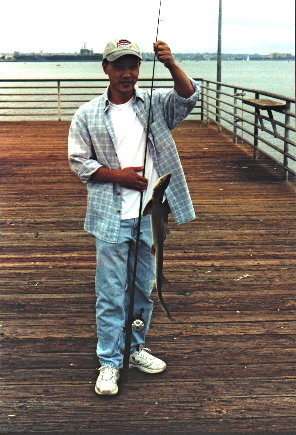
Rich Reano, “Webmaster” for Pier Fishing in California, and a small gray smoothhound shark
Date: August 31, 1997; To: Ken Jones; From: Ritchie Reano; Subject: Ferry Landing update
Hi Ken, Just got back from fishing today from the Ferry Landing Pier… Mackerel are visiting the pier in numbers. I’m seeing bucketful’s lately. Most anglers are using bait rigs sweetened with squid or mackerel. Best times seemed to be early morning or late afternoon. Smelt still cloud the waters with their abundance. Catching your own bait is a breeze.
Halibut are still hitting consistently. Most are caught on smelt. I landed a 23.5-inch halibut today using a 6-inch smelt on a sliding rig. I was also talking to a father and son team and they caught a 30″ halibut about two weeks ago using smelt. In fact, the halibut was so strong that it yanked his pole into the water. Fortunately, the pole floated and a treble gaff was on hand… Recently, a friend of mine hooked a 4-foot-wingspan ray but it came off while trying to net it. No sign of bonito. Thanks! Ritchie Reano
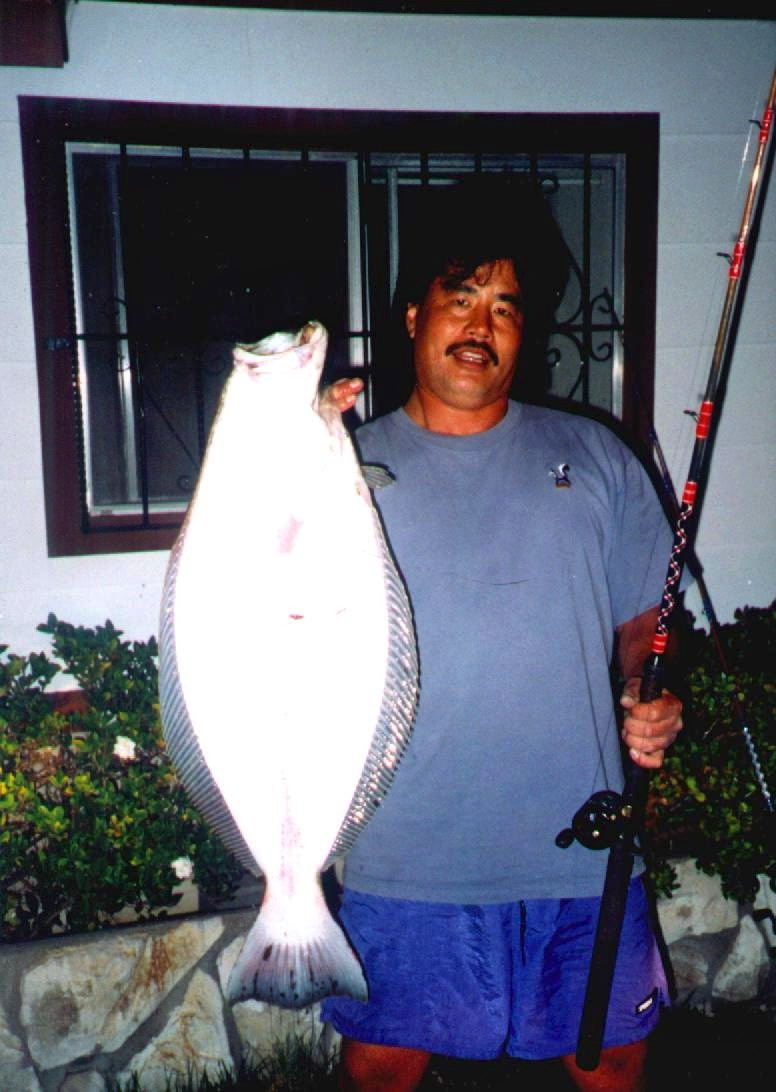
Some good-sized halibut are caught from the pier
Date: March 27, 1998; To: Ken Jones; From: Rich; Subject: Coronado
Hi Ken, I like the new website look. Have you ever considered getting a domain name? Like pierfishing.com?
Anyway, fishing is getting interesting at the Ferry Landing. During the recent grunion run, quite a few anglers were hooking up with some decent size rays. I only observed the catches during the day. The night fishing must have been even better. Another interesting catch was a nice sized barracuda, although a little short of legal. It was caught using a Salas iron jig fished on the surface. Live bait such as smelt are hard to come by at this time. Most of the smelt near the pier are much too big. Even if there’s not a lot of catching going on, it’s still a nice place to hang out on a weekend. There are shops and decent eateries only a short walk away. Take care! Sincerely, Rich Reano
To: Rich; From: Ken Jones; Subject: Domain Name
Hi Rich, In answer to your question regarding a domain name, no I don’t know too much about it. What are the advantages? Best, Ken
Ken, Your website name will be easier to remember. pierfishing.com (which by the way is available) is easier to remember than www.pacific.net/~kjcapfsh/ and looks more professional. Also, you would probably get more visits to your site. I am sure someone has tried typing in pierfishing.com to see if a website like that existed. I know I have. Sincerely, Rich
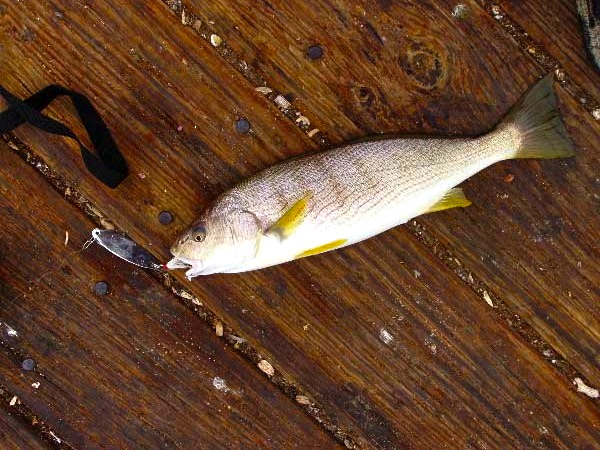
Yellowfin Croaker
Date: December 28, 1999; To: Pier Fishing In California Message Board; From: Rey; Subject: Re: Now you have my attention!
I have caught some big Needlefish at Coronado Ferry Landing. You can see them cruising near the surface from this pier. I usually don’t target them, but when I see them I use a cast and retrieve method using a long strip of squid on about 6-pound line. The faster I retrieve my bait, the better luck I get on strikes.
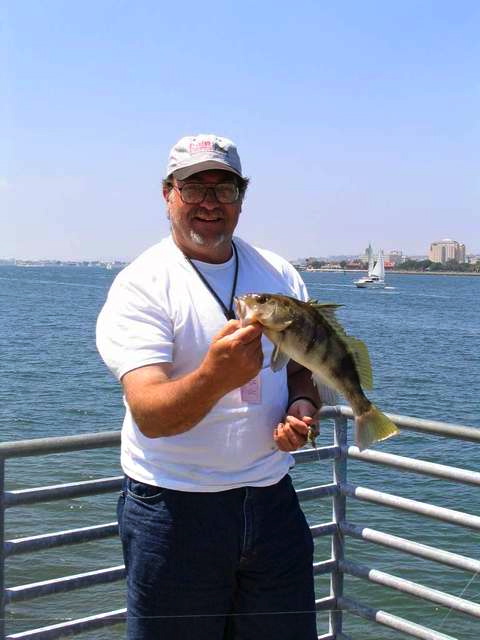
Sand bass caught by OBPierrat
Date: April 15, 2000; To: PFIC Message Board; From: Mark Taylor, LAc.; Subject: Coronado Ferry Landing report
Fished the landing this afternoon between about 4:30 – 8:00 pm, incoming tide. I’m kind of a beginner in these waters so I’m used to getting skunked, and today was no exception. Fished fresh sardines and frozen ‘chovies off the bottom. One good strike, but I didn’t set the hook in time. Tried some Fish Traps, plastic grubs and a Kroc for a while, but nothing.
There were about 10 of us on the pier and one guy fishing over near the floating ferry dock was pulling in bass after bass. Every time we looked over this dude was pulling another decent bass out of the water. I’m told he was using dines, live or dead I don’t know. He didn’t look real friendly so I didn’t ask. Two guys near me caught a too short butt, a nice keeper sand bass and what I think was a spotted bass. Same bait/rig as me.
One of these guys next to me must have caught a dozen small foot-long stingrays (or the same one 12 times; you have to wonder, they were identical in size) in an hour, until he decided to stop squandering his ghost shrimp and switch over to dines/chovies.
The rest of us did our best, but…that’s how it goes sometimes. I wonder if the place to fish on this particular pier is where that bass-o-matic guy was—over near the floating ferry dock, which forms a right angle with the fishing portion of the pier: Maybe the decent fish like to hang out in all that cover. Tight lines and good luck!
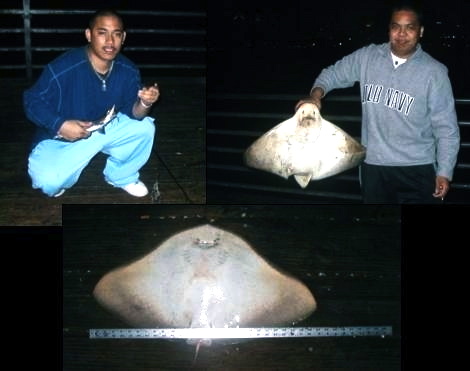
Occasionally joining in the fun with the round stingrays and diamond stingrays will be a few butterfly rays.
Date: June 30, 2002; To: PFIC Message Board; From: Rich Reano; Subject: Coronado Ferry Landing
Fished the Coronado Ferry Landing Pier for an hour from 2:30pm ~ 3:30pm hoping to catch a corvina. There were quite a bit of baitfish around but large ones were nowhere to be seen. No corvina but I did manage this spotted sand bass on a watermelon red/flake zipper worm. Got him out of the water, snapped a picture and back into the water in less than 30 seconds.
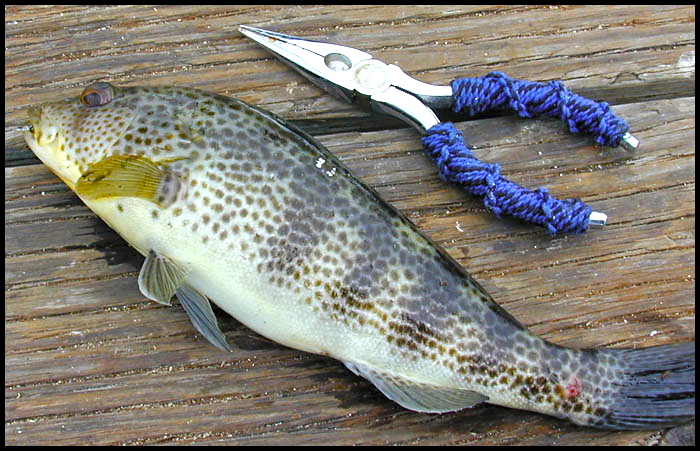
Spotted sand bass caught by Rich Reano
Date: August 13, 2002; To: PFIC Message Board; From: pEsCaDoR5312; Subject: In reply to strange people…raver fish…
I was at the pier with my brother one day (this is the Coronado Ferry Landing Pier which is probably visited by interested tourists and weirdos more often than other pier).
Well, one night the last stop of the ferry hits and two girls got off of it. I noticed they were ravers by the way they were dressed. They noticed that we were using light sticks (mackerel) and one girl asks me what we used the light sticks for. I told her they’re for “raver fish, the light stick attracts them because they like to dance around it. That’s why they call it a raver fish. Then when they see the bait they hit it.” The girl looks at me in awe and says, “that’s F***ing amazing!” So I say “yup” and they leave. My brother and I laughed about it the whole night.
*note* — raving is a style of dancing. A raver is one who likes to go to raves and dance to quasi-techno-style music. Many like to use light sticks in their hands while they are dancing to give a cool effect to their actions. I posted this story in no intentional offense toward any ravers on this board. Don’t bother me… I’m fishin. <*)))>=<| pEsCaDoR5312
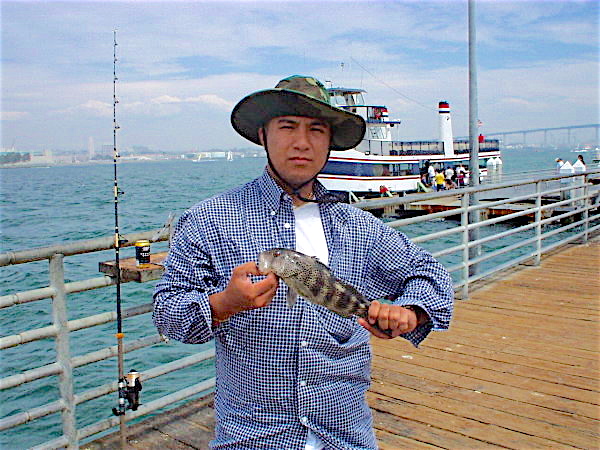
Spotted bass caught by Arvin/Pescador
Date: March 28, 2008; To: PFIC Message Board; From: woody; Subject: Ferry Landing Pier
I used to fish it back in the 90’s. Empty then. I caught the biggest bat ray in my life, (140-lbs+!!!!), and biggest shovelnose, (53-lbs!!!). I used to catch…loads of them. Bay bass, corvina, butt’s, calicos, croakers, macks, bonies, barries, needlefish, grunion, lobster, and even a few juvi white sea bass!!!! Don’t know how it is now; live in the Bay Area.
Try for butt’s at night on an incoming tide, on west end, cast live bait on slider, parallel to shore. Used to be about 1 legal to about 5 short, and FAST action!!!!
For the bats chuck squid on slider and 8/0 live bait hook as far as you can into the middle of the bay, (seems to be an oyster bed starting about 150 ft out), on an in or out tide to about an hour before or after, set your clicker and get ready, won’t be long, and you’ll catch a bunch!!!
Cast grubs near the dock, (ferry loading platform), bounce ’em and get ready for explosive calico and spotted or sand bass action, (1 out of 3 are 15 inches +!!!) Dive there during the lobster season and find HUGE bugs!! Late summer brings short barracuda with a few just at 28 inches; gotta cast far, off the northwest corner with Kocs or live smelt. Summer brings the bonies and macks, about half of them average, 1/4 of them tiny, the other 1/4 pretty damn big.
Fall full moons find the white seabass cruising by the pilings at high tide; drop a brown bait to them, and, WHAM!!!!! Measure closely, most of these are just short. When winter gets there, get some mussels, ghost shrimp, or sand crabs and fish corvina and croakers on light line, a slider, size 8 or 6 bait hook. Yellowfin, spots, and white croaker are all here. Be ready for perch to though. Used to love this place, a favorite for both fish and solitude.
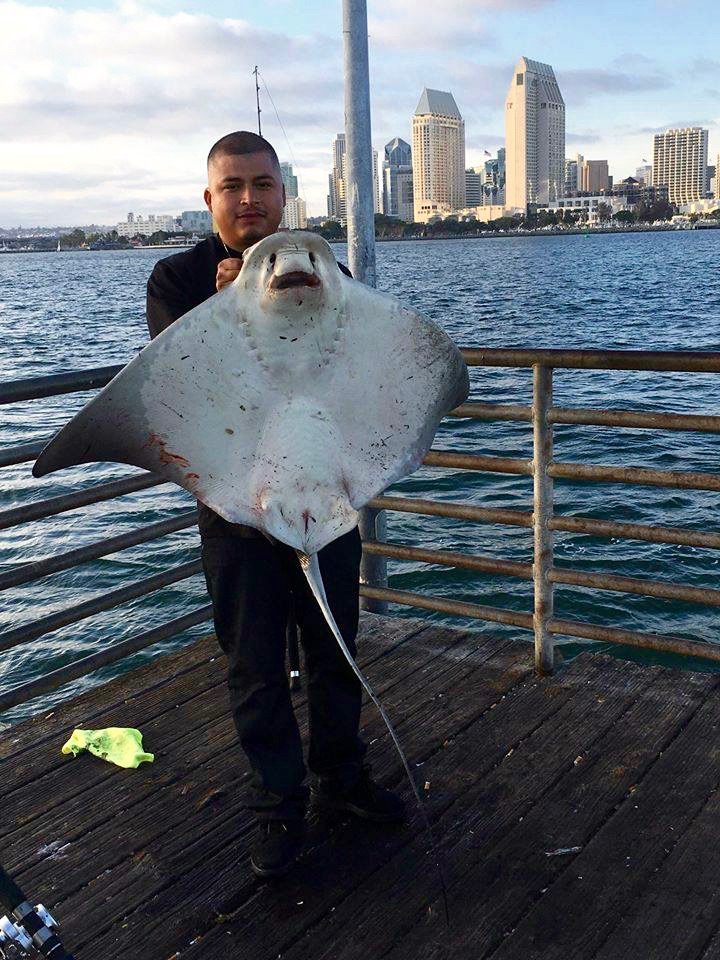
Bat ray caught by Alberto.Salgado
Date: April 9, 2008; To: PFIC Message Board; From: AaronL; Subject: Bonito
I don’t know if the boneheads are still there, but the Coronado Ferry Landing in San Diego was kicking out good numbers of bonito (to at least 5-6 lbs) about a week and a half ago. All the ones I saw were caught on small green plastic grubs rigged behind a 1–ounce chrome torpedo sinker.
Date: May 19, 2008; To: PFIC Message Board; From: aaronL; Subject: Re: Anyone fish the Ferry Landing Pier lately/shortfin corvina?
I was talking to a very successful (2 halibut and 1 WSB) man there who said that if you fished live bait or a drop shot Fluke bass bait during a grunion run, you were “guaranteed to get corvina.” I’m going to see when the next run is, and will try to fish the Coronado Pier this weekend.
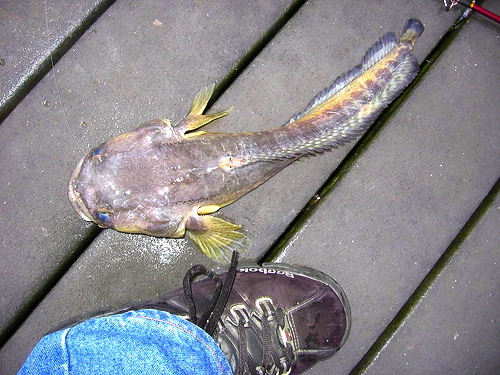
Speckled midshipman
Date: November 24, 2009; To: PFIC Message Board; From: tunafshr93; Subject: Ferry Landing Pier
Fished Ferry Landing today from 9:00 to 1:00. The macks were plentiful in the morning caught 5 in 30 minutes. One of the regulars caught 20 of them. Mackerel started being scarce after 10:00 and after that they came by about every hour. Ended up catching seven total. Water really clear could see mackerel hitting bait and swimming around. Baitfish showed up about noon. 3 stingrays caught. A Guy caught a 13” spotted bay bass and a 23” Halibut both on the live smelt which were around 4”.
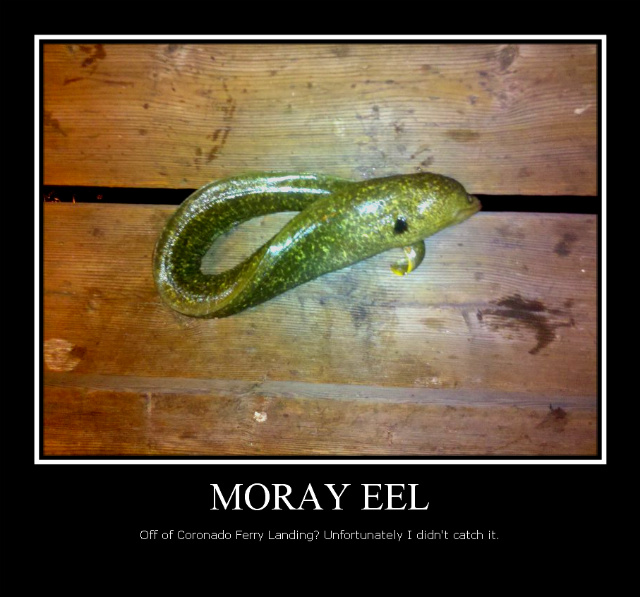
Moray eel — 2010
Potpourri — Perhaps more than you want to know about the Old Ferry Landing Pier
<*}}}}}}}}}>< — A typical scene for many years was to see an energetic young lady sitting on the rail, helping the kids, providing bait or fish to those without, or rescuing pigeons that fell into the water. She was the person I dubbed the “mom” at the pier. Her name was Shari and most days she’s would be out at the pier fishing. I watched her perform a variety of tasks during visits in 1998 and finally had to introduce myself and thank her for the help she provided the other anglers.
Fishing is only part of the pier experience, the interaction and good will between the pier rats gives value to the pier and creates a family. Every pier needs a “mom” and luckily many do indeed have people like Shari, although few are as quite as lively. She was a nice person whose behavior and actions at the pier should be emulated by others.
By the way, shortly after meeting Shari and dubbing her the “pier mom,” she gave my card to a local reporter who soon called and then did a story on the pier—and Shari. Unfortunately she’s now gone and I haven’t been able to find out what happened to her.
Fishing Season Brings Anglers Of All Ages To The Pier
Shari Rose calls out “any minute now!” when the mackerel swoop by the Coronado pier. And sure enough, the poles start bending and the silver, big-eyed mackerel are hoisted one after another out of the water, delighting the 25 or so anglers every evening. The fishing flurry is soon over. But wait about an hour, and “any minute now,” they’ll hit once again.
It’s fishing season on Coronado and anyone with a fishing pole, some squid, and a little time can catch a few. While mackerel are caught all year, they run best in the summer and have been thrilling anglers with big catches for the last two weeks…
Rose has been fishing off the Coronado pier almost every afternoon for nearly three years. In five days, Rose figures she caught 56 fish and has seen hundreds more reeled in by thrilled children, tourists, and pier regulars.
Part coach, part cheerleader, part game warden, Rose helps and encourages anyone who wants to catch a fish. She offers tips, cuts bait, unhooks fish, and measures any bass or halibut caught to make sure they’re legal keepers (22 inches for halibut, 12 inches for bass). “It’s wonderful to watch the kids. When they pull one in, it’s more fun for me than anything else,” says Rose.
Fishing on roller blades, teenager Luis Cruz caught 10 mackerel in two hours the day before. He comes on the weekends with his family to picnic at Tidelands Park and roller blades to the pier…
Ken Jones, author of Pier Fishing in California, rates the San Diego Bay as one of the best fishing spots in Southern California. The bay generally yields larger mackerel than the ocean piers in Imperial Beach and Ocean Beach. “Though it’s not big, Coronado is an excellent fishing pier,” according to Jones…
To Eat or Not Eat? While many of the fishermen on the pier say they don’t eat what they catch, most of the fish caught in the bay pose no serious health risks, according to the San Diego County Environmental Health department.
Only people who eat the fish daily over a long period of time could have problems with toxins. Pregnant women, breast feeding women, and small children especially should eat any fish in moderation. Jones offers some pointers:
- The bay is reasonably clean, although there are some polluted spots on the bottom. For this reason, don’t eat croaker and other bottom feeders since they may eat in contaminated areas.
- Mackerel, bass, and halibut are generally safe because they regularly swim in and out of the bay.
- Clean fish thoroughly, making sure to completely remove the gut and thoroughly wash the fish.
- Bake fish on a rack so that the fat breaks down and drips into the pan. Toxins are stored in the fat.
- Eat fish from any waters in moderation.
Jones adds that “its always best to catch and release fish, since fish populations are so low. Enjoy the fresh air, and get closer to nature. That’s how I like to fish,” says Jones.
—Sean Caey, Coronado Eagle, August 5, 1998
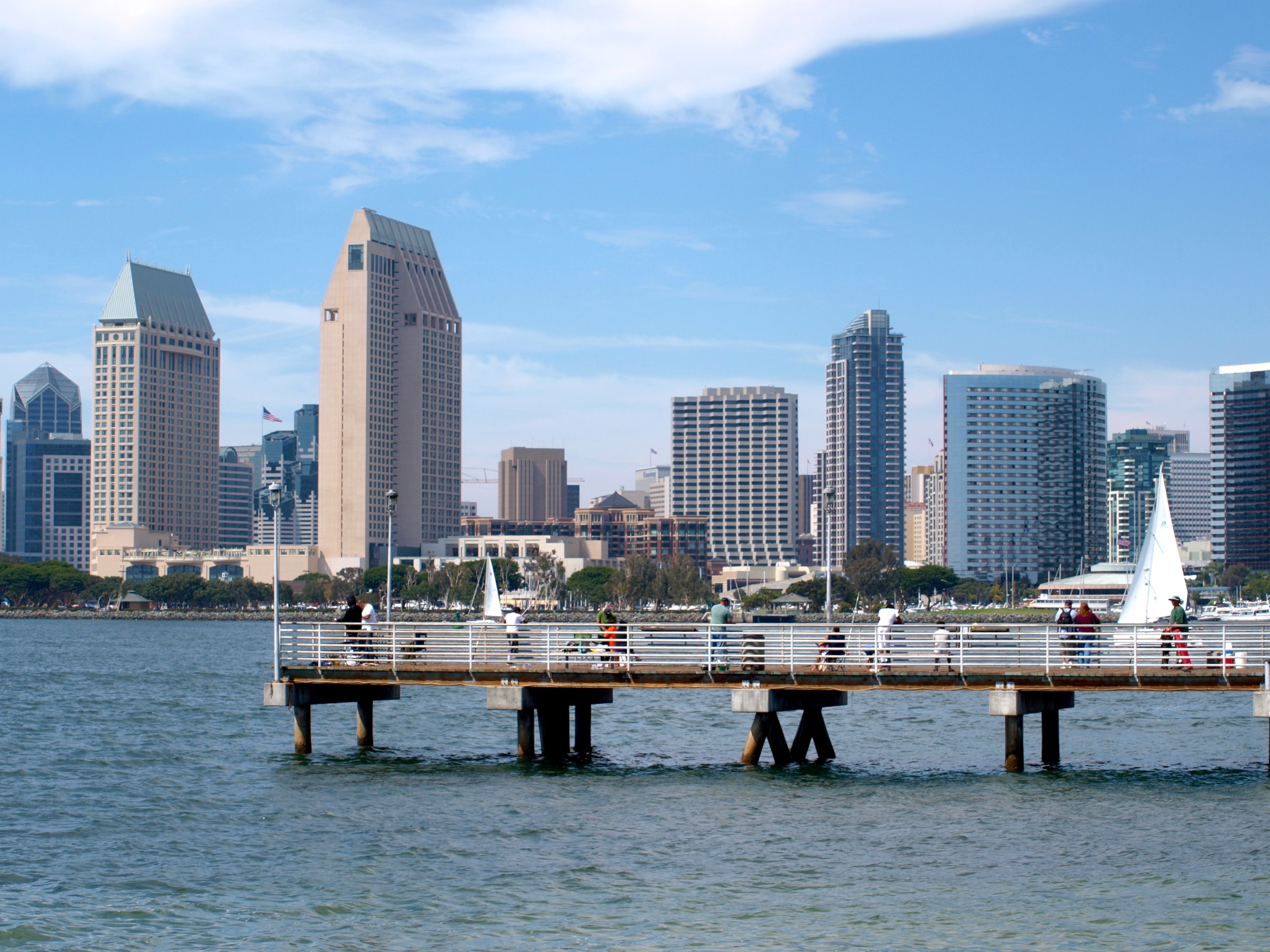
<*}}}}}}}}}>< — Oh my, how times have changed. The following discussion details how ghost shrimp (crawfish) were caught in this area back in the 1880s.
“Crawfish-tramping” these days is a lost art. Crawfish were easily obtained by removing your shoes and tramping the mud for a space three or four feet in diameter, bringing them to the surface of the mud and thereby easily providing bait for two or three to fish all day. There were no tin cans or glass in the mud in those days. You would select a place in the mud where the crawfish blowholes abounded; the finest place was on the Coronado of the Bay, from the Coronado Ferry down to Spanish Bight, a long mud-flat beach. We could go over on the ferry and back for a dime, and get more crawfish in half an hour than at the foot of Broadway in two hours. Crawfish-tramping was probably learned from the large fish—large skate, shovel-nose sharks, stingrays, halibut and other flat fish—they would select a spot where there were crawfish and they would flip up and down and bring the crawfish up. At the really low tide you could frequently see the marks where they flipped. Young boys tramped for crawfish, and carried them in little cans covered with wet seaweed, to sell as bait. Crawfish were the best bait for large-mouth, grab-at-whole-bait kind…
—Don M. Stewart, 1966, Frontier Port: A Chapter in San Diego’s History — Discussing the fishing in San Diego Bay in the late 1800s
History Note. Beginning in 1886 Coronado was connected by ferry to San Diego, a short boat ride that eliminated the need for the long journey across the “Strand” to Imperial Beach and the drive back up to San Diego.
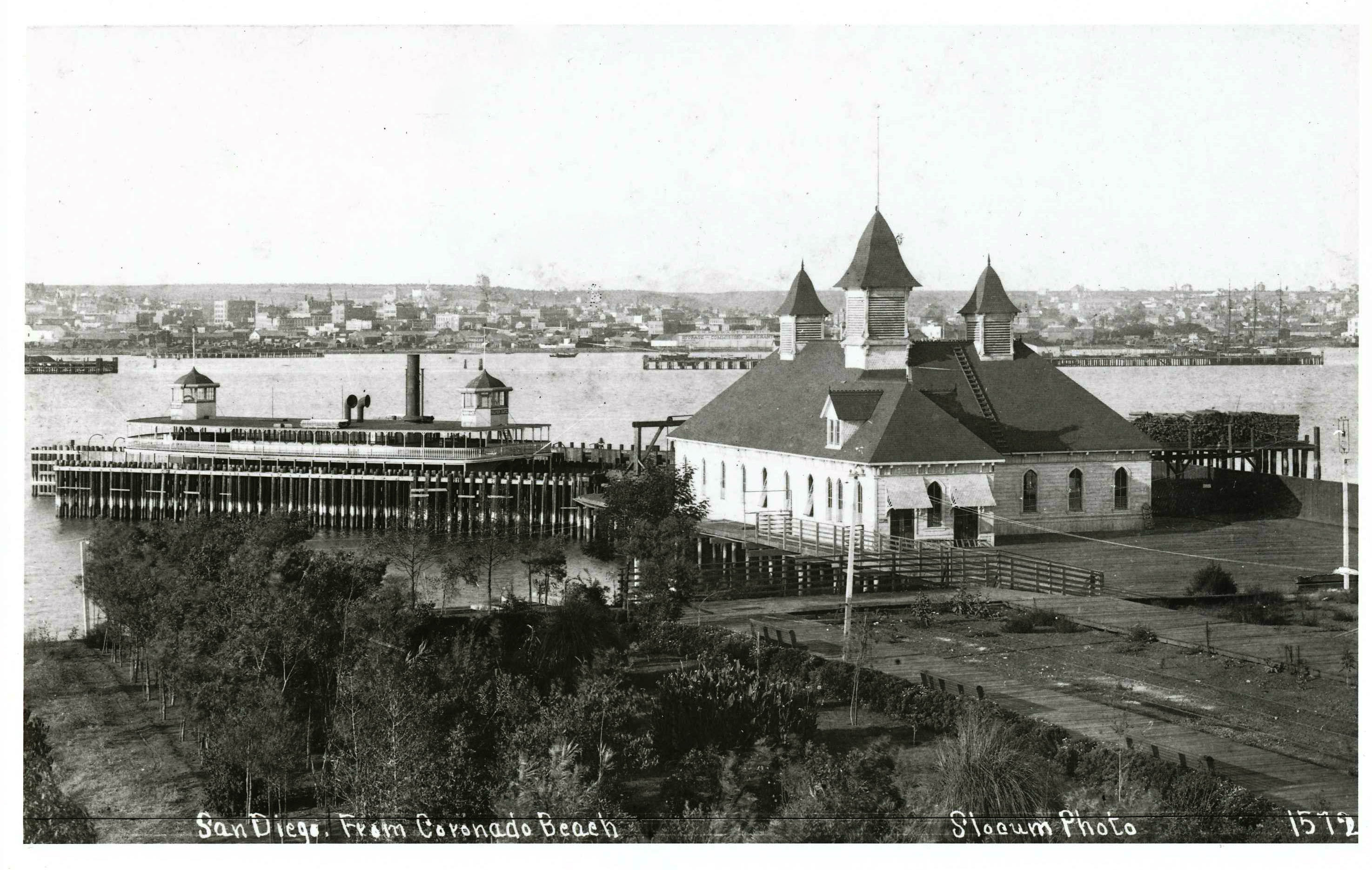
Coronado Ferry Landing — 1887
It was a no brainer but eventually someone had an even “better” idea—a bridge from San Diego to Coronado. When the Coronado Bridge was completed in 1969 it seemed to mark the end to ferry service in the bay. The old landing’s location at Orange Avenue (several blocks away from today’s ferry landing) became part of Centennial Park and though a ticket booth from the old ferry system was installed as a remembrance of the earlier times, the ferry service seemed to be just one more affectionate reminder of the area’s past.
However, less than 12 years later, in late 1981, the Coronado City Council and the San Diego Unified Port District began to study a possible return of ferry service to Coronado. In 1984 the Port Commission asked for proposals from interested firms and accepted designs for a future project (both for a ferry system and a restaurant/shopping area).
In 1985, the Star and Crescent Boat Company, the company that had operated the ferry service from 1925 to 1969, together with Southwest Marine, Inc., a shipyard operator, was ready with a proposal.
An important aspect of the overall project was the return of ferry service (to be run by the Crescent Boat Co.). The company argued that when the ferry service was shut down in 1969 it was done to avoid competition with the new Coronado Bridge and to allow the bonds for the construction costs of the bridge to be be recouped. However, the bonds, scheduled to be retired in 2003, were actually going to be retired by June/July 1986. (In fact, the bonds would actually be paid off on April Fools Day 1986). The company proposed a resumption of hourly ferry service between San Diego and Coronado.
In January 1986, the matter appeared before the Port District, which had been involved from the earliest discussions. The district was asked to grant a conceptual approval to revive the ferry as well as make a commitment to build a $600,000 ferry landing pier. The district put a 90-day delay on the proposal in order to study the issues.
Ninety days later, in April, the port commissioners agreed on the overall concept and agreed to spend $563,000 to $627,000 on a pier. The amounts varied depending on whether or not a fishing pier was included in the design. There were several remaining questions. Several commissioners were not happy about the plans for a landing float 40 by 68 feet in size. In addition, they expressed concern that the pier had to be longer and extend into deeper water to avoid nearby eel grass beds. And, they worried — would ferry passengers be endangered by the anglers if they jointly shared a ramp off the ferry as planned?
Things moved quickly and on June 20, 1986, the ferry boat Monterey made an inaugural trip from San Diego to Coronado. The ferry carried 200 people who would help launch a $6.5 million commercial-retail project (made possible, in large part, by the promised ferry service). Plans at “The Old Ferry Landing” included a 10,000 square-foot Victorian lighthouse restaurant, 30,000 square feet of specialty shops, boat slips—and a fishing pier.
By February 1987 the Public Utilities Commission had approved the ferryboat rides and the Star and Crescent Company announced the project itself would be open by June/July. The Port District cautioned that the ferry pier might not be done until August or September.
Then, in March, the Port District approved a $559,140 contract for construction of the pier. The L-shaped pier would be sectioned, one for recreational fishing and another for pedestrians and bicyclists boarding or leaving the ferry. The 20-foot-wide pier would include lighting, safety railing, fire protection, and an attached floating dock for berthing ferryboats.
In April 1987, new problems arose in a dispute between the Port District and the California Coastal Commission. The Commission said the master plan did not include docking on the San Diego side of the bay; the Port District said it did. The disagreement threatened to add four to five months for review and public hearings and push the opening date past July 1. Eventually, on May 7, the dispute was settled. But then a new dispute arose with the Port District and the developer over parking and how many fast-food shops would be permitted at the Old Ferry Landing complex. Eventually that issue also would be settled (but not in time for a July opening of the restaurant and shops).
As for the pier and the ferryboats? They both would be ready on July 1. The initial ferryboat would be the 58 ½-foot Silvergate but more were to be added. Sunrise on July 1, 1987 saw a test run followed by a VIP trip at 9 a.m. at which time the ribbon cutting ceremony took place. The first public trip was scheduled at 10 a.m. and by the end of the day more than 3,000 passengers had traveled the one-mile trip between San Diego and Coronado.
When the complex and pier first opened the center was called the “Old Ferry Landing” to give it historical appeal (although it was not actually on the location of the old ferry landing). Then, when the shopping center began to host a Farmers Market, the name was changed to the “Ferry Landing Marketplace.” Eventually that name too was changed, to today’s “Coronado Ferry Landing.” As for the pier itself, it is the lone public “fishing pier” in Coronado and receives heavy use.
Coronado Ferry Landing Pier Facts
Hours: Open 24 hours a day.
Facilities: Facilities are somewhat limited on the pier itself: a few benches, lights and bait-cutting platforms. Restrooms are located a short walk from the front of the pier in the shopping center (and are only open during the hours the shopping complex is open). Both free and metered parking is available on First Street and B Avenue (25 cents an hour with a two hour maximum, 8 a.m.- 6 p.m.). Free parking is available at the shopping complex but only for those patronizing the businesses. Bait and tackle is not available but food can be found in many of the shopping establishments.
Handicapped Facilities: Handicapped parking spaces and restrooms are located in the shopping complex. The pier surface is wood and the railing is about 40 inches high.
How To Get There: From San Diego, take the Coronado Bay Bridge (Highway 75) to Coronado. Once over the bridge you are on Third Street. Simply follow it to B Avenue, turn right, and follow it to the front of The Old Ferry Landing – the intersection of First Street and B Avenue. The pier sits behind the shops in the complex. Management: San Diego Unified Port District.
Management: San Diego Unified Port District.
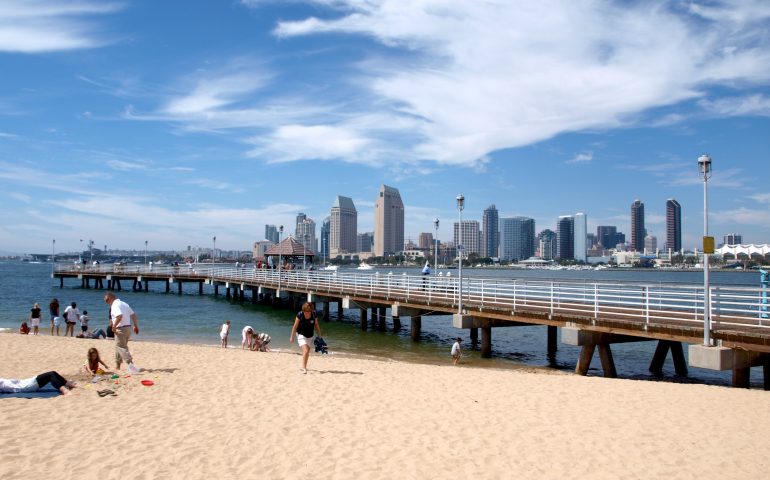
I still remember many years ago when I was a reporter for this pier. I was told that I was “lying about the Shortfin Corvina” being caught here. I posted photos and caught as many as 30 a night when most people didn’t even pursue them. I have been a longtime regular, well-known at this pier. I have caught some of the most unique species at this pier and even caught an estimated 50 plus pound Black Sea Bass and 40 plus inch Halibut here. I caught a 40 inch Marbled Snake Eel, several legal White Sea Bass and Barracuda, and a few monster Guitarfish, Bat Rays, Soupfin and Leopard Sharks over the years. I have documented several incredible Grunion runs on the beach, as well. I wish I was treated better back in the 90s when I was reporting.
[…] Grab the volleyball for a day of fun on the beach, or sit back and enjoy one of the beach’s many fire pits. Families can also enjoy the nearby picnic areas at Coronado Star Park, or spend the day fishing on the Ferry Landing Pier. […]